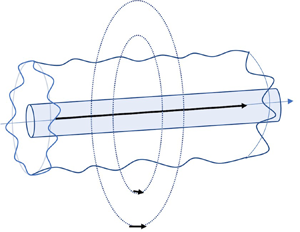Article contents
Linear stability of a ferrofluid centred around a current-carrying wire
Published online by Cambridge University Press: 19 May 2022
Abstract

Investigated first is the linear stability of a Newtonian ferrofluid centred on a rigid wire, surrounded by another ferrofluid with a different magnetic susceptibility. An electric current runs through the wire, generating an azimuthal magnetic field that produces a magnetic stress at the interface of the fluids. Three-dimensional disturbances to the system are considered, and the linearised Navier–Stokes equations are solved analytically in terms of an implicit expression for the growth rate of the disturbance. The growth rate is found numerically for arbitrary Reynolds number, and given explicitly in the inviscid and Stokes regimes. Investigated next is a ferrofluid whose magnetic susceptibility varies radially, centred on a rigid wire, subject to a non-uniform azimuthal field. It is proven that if the gradient of the susceptibility is positive anywhere in the fluid, then the system is linearly unstable. Moreover, it is proven that applying an axial field can stabilise disturbances for both continuous and discontinuous susceptibilities.
JFM classification
- Type
- JFM Papers
- Information
- Copyright
- © The Author(s), 2022. Published by Cambridge University Press
References
REFERENCES
- 3
- Cited by





